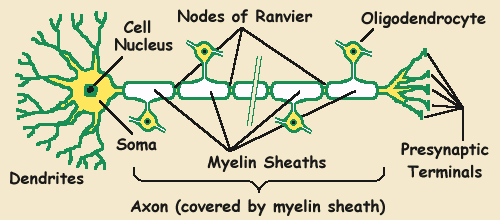axon

General structure of a vertebrate myelinated neuron.
An axon is a typically long outgrowth, or process, of a neuron that carries nerve impulses away from the cell body (soma) toward target cells. Axons are the main transmission lines of the nervous system, and as bundles they help make up nerves.
Individual axons have a diameter of only about one micrometer but may extend to macroscopic lengths. The longest axons in the human body, for example, are those of the sciatic nerve, which run from the base of the spine to the big toe of each foot and may be a meter or more long. Axons carry impulses at a rate of up to 100 meters per second; the greater the diameter of the axon, the faster the nerve impulses will travel along it.
Axons are encased in a semipermeable membrane – the phospholipid bilayer – which allows certain particles to pass through it but restricts others. In relation to the transmission of nerve impulses, this membrane selectively restricts the passage of charged particles (ions). The membrane contains special "gates" or "ion channels" that, when they are open, selectively let positively charged ions pass through. The two principle gates are the sodium and potassium channels (see sodium-potassium pump). At rest, mechanisms in the neuron pump sodium ions out of the cell to create an electric potential across the membrane. This is called the resting potential. When the nerve is excited, a explosive wave of depolarizing current called an action potential moves along the entire nerve through the length of axon and out into the presynaptic terminals. This is achieved by allowing the sodium ions to flood back through the sodium channels.
In vertebrates, the axons of many neurons are sheathed in myelin, which is formed by either of two types of glial cells: Schwann cells ensheathing peripheral neurons and oligodendrocytes insulating those of the central nervous system. Along myelinated nerve fibers, gaps in the sheath known as nodes of Ranvier occur at evenly spaced intervals, enabling an especially rapid mode of electrical impulse propagation called saltation.


